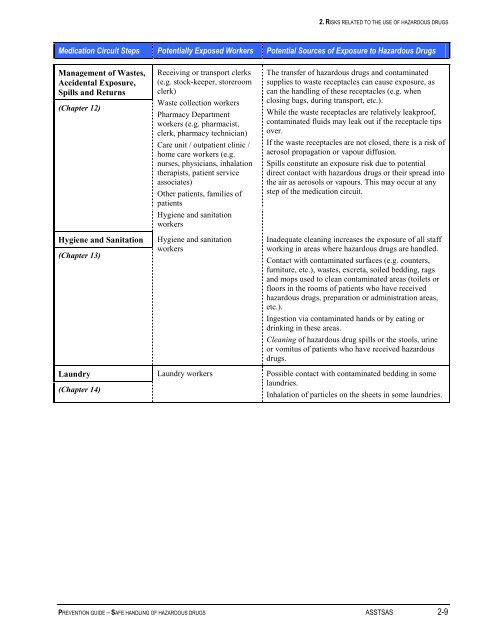Prevention Guide - Safe Handling of Hazardous Drugs - Irsst
Prevention Guide - Safe Handling of Hazardous Drugs - Irsst
Prevention Guide - Safe Handling of Hazardous Drugs - Irsst
You also want an ePaper? Increase the reach of your titles
YUMPU automatically turns print PDFs into web optimized ePapers that Google loves.
2. RISKS RELATED TO THE USE OF HAZARDOUS DRUGS<br />
Medication Circuit Steps Potentially Exposed Workers Potential Sources <strong>of</strong> Exposure to <strong>Hazardous</strong> <strong>Drugs</strong><br />
Management <strong>of</strong> Wastes,<br />
Accidental Exposure,<br />
Spills and Returns<br />
(Chapter 12)<br />
Hygiene and Sanitation<br />
(Chapter 13)<br />
Receiving or transport clerks<br />
(e.g. stock-keeper, storeroom<br />
clerk)<br />
Waste collection workers<br />
Pharmacy Department<br />
workers (e.g. pharmacist,<br />
clerk, pharmacy technician)<br />
Care unit / outpatient clinic /<br />
home care workers (e.g.<br />
nurses, physicians, inhalation<br />
therapists, patient service<br />
associates)<br />
Other patients, families <strong>of</strong><br />
patients<br />
Hygiene and sanitation<br />
workers<br />
Hygiene and sanitation<br />
workers<br />
The transfer <strong>of</strong> hazardous drugs and contaminated<br />
supplies to waste receptacles can cause exposure, as<br />
can the handling <strong>of</strong> these receptacles (e.g. when<br />
closing bags, during transport, etc.).<br />
While the waste receptacles are relatively leakpro<strong>of</strong>,<br />
contaminated fluids may leak out if the receptacle tips<br />
over.<br />
If the waste receptacles are not closed, there is a risk <strong>of</strong><br />
aerosol propagation or vapour diffusion.<br />
Spills constitute an exposure risk due to potential<br />
direct contact with hazardous drugs or their spread into<br />
the air as aerosols or vapours. This may occur at any<br />
step <strong>of</strong> the medication circuit.<br />
Inadequate cleaning increases the exposure <strong>of</strong> all staff<br />
working in areas where hazardous drugs are handled.<br />
Contact with contaminated surfaces (e.g. counters,<br />
furniture, etc.), wastes, excreta, soiled bedding, rags<br />
and mops used to clean contaminated areas (toilets or<br />
floors in the rooms <strong>of</strong> patients who have received<br />
hazardous drugs, preparation or administration areas,<br />
etc.).<br />
Ingestion via contaminated hands or by eating or<br />
drinking in these areas.<br />
Cleaning <strong>of</strong> hazardous drug spills or the stools, urine<br />
or vomitus <strong>of</strong> patients who have received hazardous<br />
drugs.<br />
Laundry Laundry workers Possible contact with contaminated bedding in some<br />
(Chapter 14)<br />
laundries.<br />
Inhalation <strong>of</strong> particles on the sheets in some laundries.<br />
PREVENTION GUIDE – SAFE HANDLING OF HAZARDOUS DRUGS ASSTSAS 2-9

















